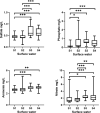Temporal patterns of bacterial communities in the Billings Reservoir system
- PMID: 38267511
- PMCID: PMC10808195
- DOI: 10.1038/s41598-024-52432-6
Temporal patterns of bacterial communities in the Billings Reservoir system
Abstract
In this study, high-throughput sequencing of 16S rRNA amplicons and predictive PICRUSt functional profiles were used to perform a comprehensive analysis of the temporal bacterial distribution and metabolic functions of 19 bimonthly samples collected from July 2019 to January 2020 in the surface water of Billings Reservoir, São Paulo. The results revealed that most of the bacterial 16S rRNA gene sequences belonged to Cyanobacteria and Proteobacteria, which accounted for more than 58% of the total bacterial abundance. Species richness and evenness indices were highest in surface water from summer samples (January 2020), followed by winter (July 2019) and spring samples (September and November 2019). Results also showed that the highest concentrations of sulfate (SO4-2), phosphate (P), ammonia (NH3), and nitrate (NO3-) were detected in November 2019 and January 2020 compared with samples collected in July and September 2019 (P < 0.05). Principal component analysis suggests that physicochemical factors such as pH, DO, temperature, and NH3 are the most important environmental factors influencing spatial and temporal variations in the community structure of bacterioplankton. At the genus level, 18.3% and 9.9% of OTUs in the July and September 2019 samples, respectively, were assigned to Planktothrix, while 14.4% and 20% of OTUs in the November 2019 and January 2020 samples, respectively, were assigned to Microcystis. In addition, PICRUSt metabolic analysis revealed increasing enrichment of genes in surface water associated with multiple metabolic processes rather than a single regulatory mechanism. This is the first study to examine the temporal dynamics of bacterioplankton and its function in Billings Reservoir during the winter, spring, and summer seasons. The study provides comprehensive reference information on the effects of an artificial habitat on the bacterioplankton community that can be used to interpret the results of studies to evaluate and set appropriate treatment targets.
© 2024. The Author(s).
Conflict of interest statement
The authors declare no competing interests.
Figures











Similar articles
-
Characterization of Bacterial Communities from the Surface and Adjacent Bottom Layers of Water in the Billings Reservoir.Life (Basel). 2022 Aug 22;12(8):1280. doi: 10.3390/life12081280. Life (Basel). 2022. PMID: 36013459 Free PMC article.
-
Spatio-temporal variation of bacterioplankton community structure in the Pearl River: impacts of artificial fishery habitat and physicochemical factors.BMC Ecol Evol. 2022 Feb 3;22(1):10. doi: 10.1186/s12862-022-01965-3. BMC Ecol Evol. 2022. PMID: 35114951 Free PMC article.
-
[Community Structure and Influencing Factors of Bacterioplankton in Spring in Zhushan Bay, Lake Taihu].Huan Jing Ke Xue. 2018 Mar 8;39(3):1151-1158. doi: 10.13227/j.hjkx.201707164. Huan Jing Ke Xue. 2018. PMID: 29965459 Chinese.
-
[Community Structure and Predictive Functional Analysis of Surface Water Bacterioplankton in the Danjiangkou Reservoir].Huan Jing Ke Xue. 2019 Mar 8;40(3):1252-1260. doi: 10.13227/j.hjkx.201806122. Huan Jing Ke Xue. 2019. PMID: 31087972 Chinese.
-
Seasonal changes of prokaryotic microbial community structure in Zhangjiayan Reservoir and its response to environmental factors.Sci Rep. 2024 Mar 6;14(1):5513. doi: 10.1038/s41598-024-55702-5. Sci Rep. 2024. PMID: 38448523 Free PMC article.
Cited by
-
Deciphering Planktonic Bacterial Community Assembly in the Storage Reservoir of the Long-Distance Water Diversion Project.Microorganisms. 2025 Feb 19;13(2):465. doi: 10.3390/microorganisms13020465. Microorganisms. 2025. PMID: 40005830 Free PMC article.
References
MeSH terms
Substances
Grants and funding
LinkOut - more resources
Full Text Sources

